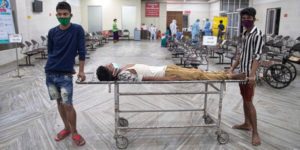[ad_1]
Migrants workers occupy every spare spot aboard trucks in Patna, India, as they attempt to get home during the coronavirus lockdown on May 17, 2020.
Santosh Kumar/Hindustan Times via Getty Images)
India’s coronavirus outbreak has exploded to 100,161 cases and 3,144 deaths. It’s now the largest in Asia.
Prime Minister Narendra Modi imposed a strict nationwide lockdown on March 25, which has since been extended multiple times.
Some restrictions have lifted, allowing the agriculture industry and small shops to reopen in an effort to revive the struggling economy.
Mumbai has been wrecked by the virus, but cases are beginning to emerge in rural areas as millions of migrant workers head home from major cities where they made their livelihood.
Visit Business Insider’s homepage for more stories.
India is not only home to 1.35 billion people, but also to Asia’s largest coronavirus outbreak.
On Monday, the country reported its largest single-day increase: 5,242 cases and 157 deaths, the Associated Press reported. That surge raised its total to 100,161 cases and 3,144 deaths.
India’s Prime Minister Narendra Modi imposed one of the world’s strictest lockdowns on March 25.
“There will be a total ban of coming out of your homes. Every district, every lane, every village will be under lockdown,” he said, according to The New York Times.
Modi estimated at the time that India needed about three weeks to curb the infection’s spread, stressing, “If we’re not able to manage the pandemic in the next 21 days, the country and your family will be set back for 21 years.”
The government has since been forced to extend the sweeping restrictions several times as the coronavirus has raced across the crowded nation. The most recent extension is set to end on May 31.

Hospital attendants with a man with a fever lying on a stretcher awaiting a coronavirus swab test at Guwahati Medical College Hospital in Assam, India, on May 17, 2020.
Anupam Nath/AP Photo
Mumbai has been hardest hit, with 20% of the country’s cases and 25% of all deaths, the Times reported.
The city of 20 million-plus residents is not only India’s financial hub but also where Bollywood and Dharavi, Asia’s largest slum, are located. According to the Times, local hospitals have been overrun and police officers are stretched thin. In Dharavi, social distancing at home is nearly impossible, as typically more than half a dozen residents live in rooms bookended by concrete slabs covered with tin roofs.
Migrant workers have been hit hard by the crisis
Among the worst of the population wracked by the virus are some 40 million migrant workers who, when jobs dried up, found themselves stranded in major cities without money or food. Some were forced to walk hundreds of miles over days to get home.
“This lockdown is totally inhuman,” lawyer-activist Prashant Bhushan, who has filed a petition in the Supreme Court seeking help for these workers to return home, told BBC News.
“Those who test negative for COVID-19 must not be forcibly kept in shelters or away from their homes and families against their wishes,” he added. “The government should allow for their safe travel to their hometowns and villages and provide necessary transportation for the same.”
Migrants wait in queues with their families to board buses to reach Ghaziabad railway station as part of their journey to their hometowns during the ongoing COVID-19 nationwide lockdow in Uttar Pradesh, India, on May 18, 2020.

Imtiyaz Khan/Anadolu Agency via Getty Images
India’s government relaxed some restrictions on May 4, allowing millions of migrants workers to travel by buses and special trains from major cities where they’d been working. This triggered a spike in infections in villages in rural areas where those people headed.
Modi, who introduced a $260 billion coronavirus relief package, is also gradually lifting restrictions to revive the economy. The agriculture industry and small shops have resumed business across multiple states and e-commerce deliveries have restarted.
But restaurants, hotels, colleges, schools, flights, and malls remain closed across the country, according to the Associated Press.
“It’s overdue as the economic impact on India is going to be quite severe,” Arvind Subramanian, a former economic adviser to the Indian government, said to The Times.
Goldman Sachs on Monday predicted that the Indian economy will shrink by 45% this quarter. The country’s GDP will decline by 5% this fiscal year, the company said, marking India’s steepest contraction since 1979.

Members of the Central Reserve Police Force patrol a coronavirus containment zone in Ranchi, India, on May 17, 2020.
Diwakar Prasad/Hindustan Times via Getty Images
Meanwhile, the lack of hygiene and lack of space to maintain social distancing continue to complicate India’s coronavirus response as is the summer — with temperatures closing in on 100 degrees Fahrenheit and making it difficult for people to stay indoors — and impending monsoons.
Also, experts worry that India’s testing rates are low, which is preventing officials from understanding the true scope of its coronavirus outbreak.
But, in a speech that hinted at the lockdown being eased further, Modi said that the country can’t be overly bogged down by the virus, The Times said.
“All the experts are telling us that corona will be part of our lives for a long period,” he said. “But we cannot allow our lives to revolve around corona, corona, corona.”
Read the original article on Business Insider
[ad_2]



